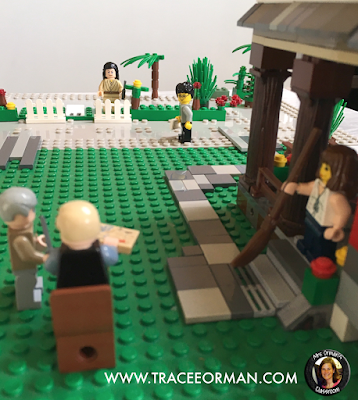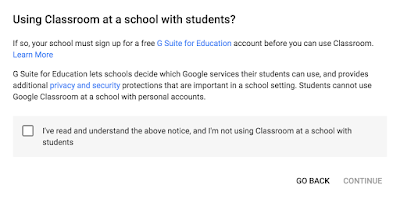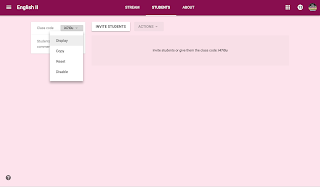Resources, activities, and lessons from a high school English/Language Arts Teacher.
Showing posts with label education. Show all posts
Showing posts with label education. Show all posts
Encourage Creativity in Your Classroom
Every single day presents an opportunity to inspire creative thought in your classroom. Whether you are reading a short story, writing an argument essay, or having a formal classroom debate, you can incorporate quick creative activities in the form of bell ringers, exit slips, enrichment projects, and more.
SHORT & QUICK CREATIVE ASSESSMENTS
Use creative questions during discussions or as bell ringers or exit slips. When you are reading a novel, short story, poem, or even a nonfiction piece, you can use questions that force students to think differently about the characters, plot, setting, tone, and author's purpose. My Creative Questions for Any Novel or Story can help! All of the question prompts (there are 180 total prompts) are aligned with the Common Core State Standards and not only require students to think creatively but critically, as well. They may seem simple, but they do force students to analyze, interpret, and synthesize elements of the text.
Example questions include:
• What is the most embarrassing thing that could happen right now in the story? Why? This question requires the student to think about past events and future predictions, character traits and motivation, and even the author's purpose.
• Does the theme of the story align more with a country or rap song? Why? Students must identify a theme of the story in order to answer this. It's much more fun and creative than just asking them what is a theme of the story. In addition, you can prompt them to identify a specific song and why they chose that song to represent the theme.
• Which character's (or historical figure's or person in general) actions made you so mad you wanted to scream? Why? I love it when characters make students feel very strongly one way or another. When a student gets worked up over a character, I know they are hooked on the story.
• If the plot is the Tour de France, would you (the reader) be pedaling uphill, coasting downhill, or stuck on a flat, twisty road going nowhere? Why? This question has multiple purposes: it assesses whether the student can identify the parts of a plot, it forces students to analyze the author's structure of the text and the pacing of the plot, and it tells me whether they are engaged in the story--if they answer that the plot is going nowhere when they are, in fact, reading a very suspenseful part, then I know they either aren't reading it or aren't into it.
• Which word from the story would win the "WORST WORD EVER USED IN A STORY" award? Why? If your students are like mine, you'll get a lot of "moist" responses. 😂But I like this question because they have to search for words in the text in a way that actually makes it somewhat fun--or at the very least, interesting--to search for a word in a text.
These are just a few of the 180 prompts in my pack. The categories for the questions include character analysis, theme, plot/events, setting, narration/point-of-view, tone/mood, language (vocabulary and figurative language), and miscellaneous, which includes symbolism among other areas.
Implementing the questions:
If you teach in a 1:1 school, you can share the questions digitally and students can respond back digitally. I liked to use our district's grading app (Skyward), that way their response is already in the grade book, so it eliminated the possibility that I would either forget to put them in the system or lose their responses altogether (yes, both have happened in the past...more than once).
If your students do not have digital devices, you can display the prompt on an overhead projector and have students respond in writing (either on the included handout sheets or in their own journals/notebooks). You can also print the questions and have students respond on the back. Because I include an editable version, you can manipulate the handouts to suit your needs.
Bell ringers/Exit slips: If I want students to recall what we read the previous day, I'll use the questions as a bell ringer. If I want to see if students were paying attention or actually reading during class, I'll use them as exit slips.
Discussion prompts: These can be used in literature circles or stations for small-group discussions, or in a large-group class discussion. I have instructions in the pack for using these in stations according to character, plot, theme, setting, tone/mood, and language analysis stations.
Grading: Usually, I grade them on completion. They are quick assessments to let me know if students are grasping the content. Unless a student obviously didn't read, they get full credit.
LONGER CREATIVE ASSESSMENTS & PROJECTS
You can also foster creative thinking through larger projects and assessments. I usually use these at the conclusion of a unit (after they have taken a written test over the unit) because many of the students' choices require them to be familiar with the text in its entirety.
I draw from my Creative Activities for Any Book pack for these choices. I think it's important to give students choices so they can choose something that interests them, especially if they did not have a choice in the book or story. I find that they are more excited about the project when it's something they choose. I've also allowed students to work together with a partner or a small group (usually no more than 3) if they wish. The pack includes almost 100 different activity prompts with handouts. It's also editable, so you can pick and choose a few for options for your students.
Examples of these include:
• Create a board game based on the novel, story, play, or historical time period. Students must be familiar with the characters, events, and theme in order to create an effective game. In addition, what is the goal or end result? How does a player "win"? These questions allow students to think differently about the text.
• Create eBay listings for items from the novel, story, play, or historical time period. This project has students look in-depth at the value of artifacts within the text, whether they are symbolic in meaning or imperative to the story.
• Write and record a parody from a scene from the novel, story, play, or historical time period. I love having my students do this after we've read/acted/watched The Tragedy of Julius Caesar by Shakespeare. Their parodies are always entertaining and they get to show off their movie-making skills. This project requires larger groups and it's always apparent if someone in the group is not contributing.
• Create a comic book version of the novel, story, play, or historical time period. Depending on the time allowed, you may have to limit it to a section rather than the entire text, especially if it's a longer book. This gives those artistic students an outlet that still requires them to analyze the text for the most important scenes and visualize them.
• Write a poem based on a scene from the novel, story, play, or historical time period. Usually, students will focus on an emotional aspect or theme that resonated with them as they write.
Although these are only a few choices I offer students, you can create your own list for your students with requirements. My pack includes the requirements for each and grading rubrics (all editable).
Grading: While the written test over the unit already covered some areas, I use these creative assessments to determine how well they connected with the text and grasped the overall themes. I usually give students the requirements for completion and a grading rubric for different areas I want to assess. (Such as quality of information, relation to the text, originality, planning, time management, neatness, etc.)
ADDITIONAL IDEAS
For additional ideas on incorporating and encouraging creativity in your classroom, take a listen Betsy Potash's podcast on her Now Spark Creativity blog 045: Memes, Interactive Notebooks, and YA with Tracee Orman. We discuss different ways to foster creative thinking with your students.
What are ways you encourage creativity in your classroom? Comment below to share.
Using Building Blocks in the Secondary Classroom
Several years ago a group of boys approached me and asked if they could recreate scenes from the book To Kill a Mockingbird by Harper Lee using LEGO™building blocks for their culminating project. This option was not on my original list of projects.
After determining that they were serious (and not just trying to get out of doing actual work), I caved and let them. And what I observed during the process was unexpected and simply marvelous. While I hoped The boys were constantly referring back to the novel to try to get the details correct. One argument was what color was Atticus's hair. They searched and searched until they found the passage in chapter 15 where Scout contrasts Jem's features with "...Atticus's graying black hair..." (Lee 203). Then they had the problem of not having black or gray hair. One boy suggested to just put a hat on him. "Atticus would never wear a hat!" another argued. I have to admit I enjoyed listening to them argue about these little details, referring back to the text, and deciding how to resolve these problems. (They went with blond for Atticus--see in the image above--making sure to tell me it was supposed to be gray.)
Above, Mr. Avery falling off Miss Maudie's roof in chapter 8 of To Kill a Mockingbird.
What I realized, though, was that this was not only a lesson in finding supporting evidence from the text, but a lesson in negotiating, communicating, and compromising with one another. And let's not forget the creativity involved. A year later when I tried this with small groups, we had the dilemma of having "people" who just didn't seem to work with our novel:
The way the students adapted the figures into the story was priceless:
Student A: Mrs. Orman, where are Spongebob's legs?
Me: I have no idea. Gone, I guess.
Student B: Well, he'll have to be Dill. You know, because he's so short.
Student A: And blond.
Student B: Perfect.
* * *
Student C: Darth Vader is obviously Bob Ewell.
Student D: Obviously.
Student C: So who will Boo be?
Student D: Are you kidding? Boo is a Ninja. He was always a Ninja. I can't believe we are having this conversation.
* * *
Student E: Why is Tom a Stormtrooper?
Student F: Because his face is black.
Student E: That is so racist.
Student F: How is that racist when it's just a fact?
Student E: Because you are white, Dude. You can't say things like that. And because we have this thing here missing an arm. That's clearly Tom.
Student F: Now who's being racist?!
Student E: Dude, that's not racist.
Student G (from another group, yelling across the room): There's more to people than just their looks, Guys!
Student E: Ok, well Stormtroopers are evil and Tom's the innocent one here.
Student F: What about Finn? He's good and he was a Stormtrooper.
Student E: But Tom didn't start evil and turn good. Tom was always a good man.
Student F: Fine. Tom will be the brown robot with one arm. But what if this thing is just as bad as a Stormtrooper? We know nothing about this robot.
Student E: He was a caring robot who lived his life helping others. I already created a whole backstory for him...
* * *
I actually prefer using figures who may not fit the mold in order to push students to think more critically and creatively about the characters.
"Boo is a Ninja. He was always a Ninja..."
PREPARING FOR THE ACTIVITY
Before trying this in class, make sure you are prepared with enough building blocks for students (this was the first challenge the group faced). One boy in the group brought in a small box that they thought would be sufficient; unfortunately, the pieces were designed to build vehicles rather than structures. The next day they brought in a five-gallon tub full, which was more than sufficient.
Below is an example of how many blocks it may take to build a simple scene outside a jail cell. Keep in mind that the structures do not have to be complete (only two sides of this jail cell are finished):
Here are some other examples requiring a few more blocks:
IMPLEMENTING THE ACTIVITY IN THE CLASSROOM
You'll want to determine the skills you wish students to practice. The more you ask of them, the longer they will need to practice them.
GROUP PROJECT:
The skills I wanted students to practice with the group project (2-3 class periods) included inferring and interpreting scenes from the novel and creating a visual representation of the inferences. I also wanted them to communicate in writing a summary of the project.
I required the group of four boys to show me four different scenes from the book and explain (both orally and in writing) why they chose the scenes, which details they wanted to make sure they included in each, why those details were important, and the problems they encountered and how they resolved them within the group. Each member took on the responsibility for writing about one of the scenes but, for the most part, they all had a hand in building all four scenes. The group had three class periods to complete the project.
END-OF-THE-CHAPTER or EXIT ACTIVITY:
For a shorter activity (10-20 minutes), the skills I wanted students to practice were similar: inferring and interpreting scenes from the chapter and creating a visual representation based on the inferences.
Students split into small groups and each group got a little pile of blocks (enough to build at least one or two walls) and two figures. I asked each group to select a scene to reenact from the chapter we had just completed reading in class. If they wanted more blocks, they had to answer a question from the novel (from any of the previous chapters) to earn more blocks or props. Some students negotiated with students from other groups to trade blocks, which was fine with me. At the end of the period, I did not allow them to save their work because I had to reuse the blocks for the next class period. I recommend taking pictures of them, though, that you can display after every class period/section has completed the exercise.
If you wish to incorporate the writing component, you could use it as a bell-ringer the following day. Ask students to reflect on the previous day's activity and write why they chose the scene, which details they made sure to include, and problems they may have faced and how their group rectified them.
CREATIVE ACTIVITIES FOR ANY BOOK
If you like this idea, I have plenty more in my pack: Creative Activities for ANY Book or Story. They are all aligned with the Common Core State Standards, so you don't have to feel guilty for incorporating more creativity into your classroom.
The following pictures are additional examples from To Kill a Mockingbird. Can you identify the scene?
* The scene depicted is from chapter 4 when the children are acting out the "Boo Radley" game. It's a combination of when Miss Maudie sees them--the screwdriver is her hedge clippers--and when the children are acting out "Chapter XXV, Book II of One Man's Family" and Atticus sees them (Lee 53).
Work cited:
Lee, Harper. To Kill a Mockingbird. 1960. Hachette Book Group, 2010.
Celebrate the Holidays in Your Classroom
Thanks so much for visiting my blog for Day 12 of the 12 Days of December Holiday Blog Hop!
Incorporating comfort and joy into your classroom during the holiday season can be as easy as a lesson relating to the holidays or announcing a contest or challenge to your fellow staff members.
REGIFTING: YAY OR NAY?
Regifting: most of us are guilty of regifting something at least once in our lives. What do your students think about regifting? You can have some engaging arguments in your classroom on the topic.
My nonfiction argument lesson on regifting contains "pro" and "con" articles on regifting. Students read both sides, analyze both arguments, then decide which side of the debate they fall. It also includes a role-play activity, an infographic assignment where students collect their own data and create an infographic based on their findings, and a writing component in which students form their own arguments on regifting using the data and research they collected.
HOLIDAY COLORING PAGES
Coloring and doodling aren't just for children. CNN reported last year that coloring can "...reduce anxiety, create focus or bring about mindfulness." We all know students (and teachers) who can benefit from less tension and improved concentration and mindset.
My Christmas and Holiday coloring pages are geared toward teens and are perfect for decorating your classroom for the holidays. The winter-themed pages can be used for the entire season.
 |
| Students who like to doodle will love the doodle pages included. |
DOOR DECORATING CONTEST
Last year when some teachers at my high school decided to have a holiday door decorating contest, little did we know how much joy it would bring to not only the students but the entire staff.
The guidelines were very simple: decorate your door for the holidays and complete it within a week. You could do it yourself or have your students help you during our common 8th period study hall.
Since there weren't any stipulations, pretty much anything holiday-related was acceptable. Some teachers used their content area for inspiration, like my fellow English teacher's "Winter PoeTree," complete with poems written by students:
Or by our P.E. teachers on the locker room doors:
And by one of our math teachers:
 |
 |
| Our computers/business teacher's door. |
 |
| One of our science teacher's door. Names on the stockings are students from Physics class. |
While others used iconic holiday characters like the Grinch, Snoopy, and Olaf:
 |
| A math teacher's door. |
 |
| The special education room. |
 |
| Another math teacher's door. |
Even our principal and office staff got in on the fun:
 |
| Our principal's office door. The student office workers and secretaries made the "Nice" list; our principal and athletic director made the "Naughty" list. |
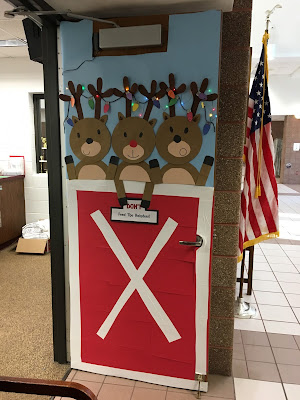 |
| The door to the main office. |
For my door, I decided to go with one of my favorite holiday movies as inspiration: A Christmas Story. I debated on whether the leg lamp would be appropriate but thought I would take my chances. I decided I wanted the outside of the box on the outside of my door and the lamp on the inside of my door:
I used large rolls of printed paper in woodgrain patterns for the box and the window frame and stars for the sky. (Most of the supplies I used were leftover from Homecoming float-building and Prom decorating supplies or Christmas decorations I happened to have.)
Our school has an excellent color photocopier with an enlargement feature that will print a giant image on several pieces of 11x14 in. paper (you just need to piece them together). I used this feature to print the leg lamp and the larger images of the characters. I made two copies of the lampshade so I could tape battery-operated fairy lights under the top layer of the lampshade. To add another three-dimensional feature, I taped real black fringe to the bottom of the top layer lamp shade.
Then things got a little out of control...
Once I started decorating around the door, I just couldn't stop. And there were so many parts of the movie I wanted to include! So I added the Bumpus dogs, Scut Farkus, the famous "You'll shoot your eye out" quote, Ralphie in his cowboy outfit, his C+ essay, the Little Orphan Annie Decoder and Ovaltine message, Ralphie in his pink bunny gift, Randy's zeppelin, the Old Man's bowling ball, the Red Ryder BB gun, the Old Man's "Fra-Gee-Lay" quote, Ralphie's mom correcting him, Ralphie dropping the lugnuts and saying "Oh Fudge," LifeBuoy soap, Randy in his snow suit "I can't move my arms," the triple-dog dare, Flick's tongue on the pole, and Scut and Grover Dill. (The "retweets" comment was because a student had recently said he would tackle a Christmas tree if his tweet got 150 retweets.)
The total cost of this door was less than $3 (the black fringe was the only thing I purchased) because I was able to repurpose leftover decorating supplies and use holiday decorations I already had on hand. Of course, being able to use our school's photocopier helped keep costs down.
I'll post pictures from this year's door decorating contest in a separate blog, so make sure to follow me to get updates. This year's theme is any holiday song; I'll be helping my husband with his social-studies classroom door.
GIVEAWAY
Bringing comfort and joy into your classroom doesn't have to be complicated, of course. A simple string of lights, playing of a holiday song as students walk in the classroom, or wearing an "ugly" holiday sweater can be enough to bring a smile to your students' faces.
Make sure you check out Hello Teacher Lady and Write On with Miss G's blog posts, as well!
Thanks so much for stopping by AND don't forget to ENTER to win the final prize: a $200 Amazon Gift Card! You can enter to win here:
a Rafflecopter giveaway
Or by clicking here: 12 Days of December
I hope you obtained many great ideas from my fellow bloggers for bringing comfort and joy into your classroom!
Getting Started on Google Classroom™
Getting Started on Google Classroom™
Now that you have decided HOW to set up your classes on Classroom™, it's time to start creating them. I will take you through the steps, explaining each one. You can also view the video screen recordings I've embedded to follow along.
PLEASE NOTE: Using Classroom™does require that your school has a free G Suite for Education account. If you are using it with a personal account, this window will appear:
In order for your documents and students' work to be private and secure, your school should set up a G suite account.
CREATING A NEW CLASS
After you have opened Classroom™, you will arrive on the Home screen. To add a class, click on the plus (+) sign in the top right of the screen.
A pop-up window will appear, which looks like this:
You will fill out the name of the class (i.e. English II, Algebra I, Government, etc.). You can leave the other lines blank or fill them in. If you are setting up multiple sections for the same class, you can label the sections:
When you click "Create," your class is created and will look similar to this:
CUSTOMIZING THE LOOK OF YOUR CLASS
To change the look of the class, use the "Select theme" or "Upload photo" options on the right side of the screen.
When you select the theme, you are given options in a "Gallery." You can also select "Patterns" for additional selections.
If you choose to upload a photo, make sure the dimensions are 2000 x 400 pixels (or 20.833 x 4.1667 inches).
Watch a video recap of these directions here:
ADD CLASSROOM MATERIALS
TIP: After you make your class look the way you want, click on the "About" section to add another teacher, attach classroom materials (i.e. if you have an online textbook or other digital materials that are essential for the class, THIS is where you can attach them), view your Classroom Drive folder, and/or Classroom calendar. See in the video below:
Your students will be able to access these materials anytime they need them without having to search the class stream.
ADDING ANOTHER TEACHER
If you co-teach a class, have a teacher's aide, or want to give another teacher (i.e. a special education teacher) access to your class, you can also do this in the "About" section. Just click on the "Invite Teacher" button and enter the email. The teacher will be able to do everything you can do except delete the class.
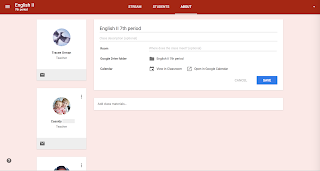 |
| You can add details about the class in the "About" section. |
TIP: If you just want to give an aide or another teacher access to the assignments and class materials, it may be better to add them as a student. Most of my aides just wanted a copy of the online assignments so they could type in notes or answers for themselves. When they had access as a teacher, their notes would appear on every student copy because co-teachers do not get their own copy of the assignment like students do; they have access to YOUR original document. At the time of this blog post, Google Classroom™ does not allow you to set parameters for other teachers. If you still wish to give another teacher or aide full access, let them know ahead of time that if they plan to type on any documents you share, they MUST make a copy of the file first or it will mess up your template for the students.
ADDING STUDENTS
You can add students to your class manually by typing in their email addresses. But that can be very time-consuming. Every class has a unique class code. It's much easier to share your class code with your students and have them add themselves. They will click on "Join class" on their home page, then enter the code you share with them.
You have the ability to display your class code from your screen (using a projector or smart board) to share it with students:
This is also where you can set parameters for your students. Do you want them to be able to create posts? Comment on posts? Or neither? I have found that for some classes, I welcome the feedback and interaction of the students and for others, I had to disable all comment privileges because they made inappropriate remarks. You will need to decide what is best for your classes.
Here's a recap video for adding other teachers and students to your class:
In the next post, I will show you how to add an announcement, assignment, poll your students, start a class discussion, and reuse a post from an archived or another class.
Here are ALL of my Google Classroom™ posts:
Tips for secondary teachers on how you should set up your classes (pros and cons of having one Classroom per subject or one Classroom per class period).
Includes tips and tutorials for creating new classes; customizing the look of your classes; adding new materials/online text; adding students; and adding co-teachers, teacher aides, or access for special education teachers.
Includes tips and tutorials for creating assignments, announcements, and topics. Also has tips on how to save and delay posting and collecting work for students.
Includes tips and tutorials for creating questions, the types of questions available (multiple choice & short answer), allowing students to interact and respond to one another, and how to easily reuse posts from class to class and year to year.
Google Classroom™ is a trademark of Google Inc. Use of this trademark is subject to Google Brand Permissions.
Subscribe to:
Comments (Atom)















